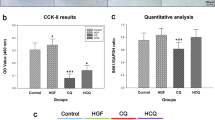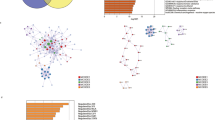Abstract
The pro-inflammatory cytokine interleukin 6 (IL-6), via activating its downstream JAK/STAT3 and Ras/ERK signaling pathways, is involved in cell growth, proliferation and anti-apoptotic activities in various malignancies. To screen inhibitors of IL-6 signaling, we constructed a STAT3 and ERK dual-pathway responsive luciferase reporter vector (Co.RE). Among several candidates, the natural compound 20(S)-25-methoxyl-dammarane-3β, 12β, 20-triol (25-OCH3-PPD, GS25) was identified to clearly inhibit the luciferase activity of Co.RE. GS25 was confirmed to indeed inhibit activation of both STAT3 and ERK pathways and expression of downstream target genes of IL-6, and to predominantly decrease the viability of HepG2 cells via induction of cell cycle arrest and apoptosis. Interestingly, GS25 showed preferential inhibition of HepG2 cell viability relative to normal liver L02 cells. Further investigation showed that GS25 could not induce apoptosis and block activation of STAT3 and ERK pathways in L02 cells as efficiently as in HepG2 cells, which may result in differential effects of GS25 on malignant and normal liver cells. In addition, GS25 was found to potently suppress the expression of endogenous STAT3 at a higher concentration and dramatically induce p38 phosphorylation in HepG2 cells, which could mediate its anti-cancer effects. Finally, we demonstrated that GS25 also inhibited tumor growth in HepG2 xenograft mice. Taken together, these findings indicate that GS25 elicits its anti-cancer effects on HepG2 cells through multiple mechanisms and has the potential to be used as an inhibitor of IL-6 signaling. Thus, GS25 may be developed as a treatment for hepatocarcinoma with low toxicity on normal liver tissues as well as other inflammation-associated diseases.






Similar content being viewed by others
References
Kishimoto T (2005) Interleukin-6: from basic science to medicine–40 years in immunology. Annu Rev Immunol 23:1–21. doi:10.1146/annurev.immunol.23.021704.115806
Middleton K, Jones J, Lwin Z, Coward JI (2014) Interleukin-6: an angiogenic target in solid tumours. Crit Rev Oncol Hematol 89(1):129–139. doi:10.1016/j.critrevonc.2013.08.004
Guo Y, Xu F, Lu T, Duan Z, Zhang Z (2012) Interleukin-6 signaling pathway in targeted therapy for cancer. Cancer Treat Rev 38(7):904–910. doi:10.1016/j.ctrv.2012.04.007
He G, Dhar D, Nakagawa H, Font-Burgada J, Ogata H, Jiang Y, Shalapour S, Seki E, Yost SE, Jepsen K, Frazer KA, Harismendy O, Hatziapostolou M, Iliopoulos D, Suetsugu A, Hoffman RM, Tateishi R, Koike K, Karin M (2013) Identification of liver cancer progenitors whose malignant progression depends on autocrine IL-6 signaling. Cell 155(2):384–396. doi:10.1016/j.cell.2013.09.031
Ohishi W, Cologne JB, Fujiwara S, Suzuki G, Hayashi T, Niwa Y, Akahoshi M, Ueda K, Tsuge M, Chayama K (2014) Serum interleukin-6 associated with hepatocellular carcinoma risk: a nested case-control study. Int J Cancer 134(1):154–163. doi:10.1002/ijc.28337
Songur N, Kuru B, Kalkan F, Ozdilekcan C, Cakmak H, Hizel N (2004) Serum interleukin-6 levels correlate with malnutrition and survival in patients with advanced non-small cell lung cancer. Tumori 90(2):196–200
Salgado R, Junius S, Benoy I, Van Dam P, Vermeulen P, Van Marck E, Huget P, Dirix LY (2003) Circulating interleukin-6 predicts survival in patients with metastatic breast cancer. Int J Cancer 103(5):642–646. doi:10.1002/ijc.10833
Hong DS, Angelo LS, Kurzrock R (2007) Interleukin-6 and its receptor in cancer: implications for translational therapeutics. Cancer 110(9):1911–1928. doi:10.1002/cncr.22999
Trikha M, Corringham R, Klein B, Rossi JF (2003) Targeted anti-interleukin-6 monoclonal antibody therapy for cancer: a review of the rationale and clinical evidence. Clin Cancer Res 9(13):4653–4665
Pang XH, Zhang JP, Zhang YJ, Yan J, Pei XQ, Zhang YQ, Li JQ, Zheng L, Chen MS (2011) Preoperative levels of serum interleukin-6 in patients with hepatocellular carcinoma. Hepatogastroenterology 58(110–111):1687–1693. doi:10.5754/hge10799
Hirano T, Ishihara K, Hibi M (2000) Roles of STAT3 in mediating the cell growth, differentiation and survival signals relayed through the IL-6 family of cytokine receptors. Oncogene 19(21):2548–2556. doi:10.1038/sj.onc.1203551
Darnell JJ (1997) STATs and gene regulation. Science 277(5332):1630–1635
Bournazou E, Bromberg J (2013) Targeting the tumor microenvironment: JAK-STAT3 signaling. JAKSTAT 2(2):e23828. doi:10.4161/jkst.23828
Yu H, Jove R (2004) The STATs of cancer–new molecular targets come of age. Nat Rev Cancer 4(2):97–105. doi:10.1038/nrc1275
Leu CM, Wong FH, Chang C, Huang SF, Hu CP (2003) Interleukin-6 acts as an antiapoptotic factor in human esophageal carcinoma cells through the activation of both STAT3 and mitogen-activated protein kinase pathways. Oncogene 22(49):7809–7818. doi:10.1038/sj.onc.1207084
Akira S, Kishimoto T (1992) IL-6 and NF-IL6 in acute-phase response and viral infection. Immunol Rev 127:25–50
Rodriguez-Berriguete G, Prieto A, Fraile B, Bouraoui Y, de Bethencourt FR, Martinez-Onsurbe P, Olmedilla G, Paniagua R, Royuela M (2010) Relationship between IL-6/ERK and NF-kappaB: a study in normal and pathological human prostate gland. Eur Cytokine Netw 21(4):241–250. doi:10.1684/ecn.2010.0211
Wang W, Zhao Y, Rayburn ER, Hill DL, Wang H, Zhang R (2007) In vitro anti-cancer activity and structure-activity relationships of natural products isolated from fruits of Panax ginseng. Cancer Chemother Pharmacol 59(5):589–601. doi:10.1007/s00280-006-0300-z
Zhao Y, Wang W, Han L, Rayburn ER, Hill DL, Wang H, Zhang R (2007) Isolation, structural determination, and evaluation of the biological activity of 20(S)-25-methoxyl-dammarane-3beta, 12beta, 20-triol [20(S)-25-OCH3-PPD], a novel natural product from Panax notoginseng. Med Chem 3(1):51–60
Bi X, Zhao Y, Fang W, Yang W (2009) Anticancer activity of Panax notoginseng extract 20(S)-25-OCH3-PPD: Targetting beta-catenin signalling. Clin Exp Pharmacol Physiol 36(11):1074–1078. doi:10.1111/j.1440-1681.2009.05203.x
Wang W, Rayburn ER, Zhao Y, Wang H, Zhang R (2009) Novel ginsenosides 25-OH-PPD and 25-OCH3-PPD as experimental therapy for pancreatic cancer: anticancer activity and mechanisms of action. Cancer Lett 278(2):241–248. doi:10.1016/j.canlet.2009.01.005
Wang W, Rayburn ER, Hang J, Zhao Y, Wang H, Zhang R (2009) Anti-lung cancer effects of novel ginsenoside 25-OCH(3)-PPD. Lung Cancer 65(3):306–311. doi:10.1016/j.lungcan.2008.11.016
Voruganti S, Qin JJ, Sarkar S, Nag S, Walbi IA, Wang S, Zhao Y, Wang W, Zhang R (2015) Oral nano-delivery of anticancer ginsenoside 25-OCH3-PPD, a natural inhibitor of the MDM2 oncogene: Nanoparticle preparation, characterization, in vitro and in vivo anti-prostate cancer activity, and mechanisms of action. Oncotarget 6(25):21379–21394. doi:10.18632/oncotarget.4091
Wang W, Zhang X, Qin JJ, Voruganti S, Nag SA, Wang MH, Wang H, Zhang R (2012). Natural product ginsenoside 25-OCH3-PPD inhibits breast cancer growth and metastasis through down-regulating MDM2. PLoS ONE 7(7), e41586. doi:10.1371/journal.pone.0041586
Zhao C, Su G, Wang X, Zhang X, Guo S, Zhao Y (2016) Antitumor activity of ginseng sapogenins, 25-OH-PPD and 25-OCH3-PPD, on gastric cancer cells. Biotechnol Lett 38(1):43–50. doi:10.1007/s10529-015-1964-4
Zhang Y, Bao YL, Wu Y, Yu CL, Sun Y, Li YX (2010) Identification and characterization of the human SLC5A8 gene promoter. Cancer Genet Cytogenet 196(2):124–132. doi:10.1016/j.cancergencyto.2009.09.004
Gao XL, Lin H, Zhao W, Hou YQ, Bao YL, Song ZB, Sun LG, Tian SY, Liu B, Li YX (2016) JA, a new type of polyunsaturated fatty acid isolated from Juglans mandshurica Maxim, limits the survival and induces apoptosis of heptocarcinoma cells. Apoptosis 21(3):340–350. doi:10.1007/s10495-015-1202-5
Han J, Sun P (2007) The pathways to tumor suppression via route p38. Trends Biochem Sci 32(8):364–371. doi:10.1016/j.tibs.2007.06.007
Wu YL, Wan Y, Jin XJ, OuYang BQ, Bai T, Zhao YQ, Nan JX (2011) 25-OCH3-PPD induces the apoptosis of activated t-HSC/Cl-6 cells via c-FLIP-mediated NF-kappaB activation. Chem Biol Interact 194(2–3):106–112. doi:10.1016/j.cbi.2011.08.010
Deng J, Qian Y, Geng L, Chen J, Wang X, Xie H, Yan S, Jiang G, Zhou L, Zheng S (2008) Involvement of p38 mitogen-activated protein kinase pathway in honokiol-induced apoptosis in a human hepatoma cell line (hepG2). Liver Int 28(10):1458–1464. doi:10.1111/j.1478-3231.2008.01767.x
Bode JG, Ehlting C, Haussinger D (2012) The macrophage response towards LPS and its control through the p38(MAPK)-STAT3 axis. Cell Signal 24(6):1185–1194. doi:10.1016/j.cellsig.2012.01.018
Tanaka T, Narazaki M, Kishimoto T (2014). IL-6 in inflammation, immunity, and disease. Cold Spring Harb Perspect Biol, 6(10):a16295. doi:10.1101/cshperspect.a016295
Yao X, Huang J, Zhong H, Shen N, Faggioni R, Fung M, Yao Y (2014) Targeting interleukin-6 in inflammatory autoimmune diseases and cancers. Pharmacol Ther 141(2):125–139. doi:10.1016/j.pharmthera.2013.09.004
Cao W, Liu Y, Zhang R, Zhang B, Wang T, Zhu X, Mei L, Chen H, Zhang H, Ming P, Huang L (2015) Homoharringtonine induces apoptosis and inhibits STAT3 via IL-6/JAK1/STAT3 signal pathway in Gefitinib-resistant lung cancer cells. Sci Rep 5:8477. doi:10.1038/srep08477
Liu Y, Li PK, Li C, Lin J (2010) Inhibition of STAT3 signaling blocks the anti-apoptotic activity of IL-6 in human liver cancer cells. J Biol Chem 285(35):27429–27439. doi:10.1074/jbc.M110.142752
Acknowledgements
We would like to thank Xiu-Li Gao and Wen-Jing Zhang for helpful guidance in data analysis and experimental methods; Yi-Meng Wang, Xiao-Jia Liu and Xin Xu for animal experiments; Li-Hua Zheng, Ying Sun and Guan-Nan Wang for technical support. We also thank the supporting grants from the National Natural Science Foundation of China (No. 81372870), National Key New Drug Creation and Manufacturing Program of Ministry of Science and Technology (No. 2013ZX09103003004), Fundamental Research Funds for the Central Universities, Grant of Jilin Province Science & Technology Committee (Nos. 20110711, 20150204038YY, 20130206072YY, YYZX201121, 20130201008ZY, 20150309003YY and 20170414028GH), Grant of Administration of Traditional Chinese Medicine of Jilin Province (2014-ZDR) and Grant of Changchun Science & Technology Committee (Nos. 2014070, 2013314).
Author information
Authors and Affiliations
Corresponding authors
Ethics declarations
Conflict of interest
The authors declare that they have no conflict of interest.
Ethical approval
Animal experiments were approved by the Ethics Committee of our institution and were performed in accordance with Regulations for the Administration of Affairs Concerning Experimental Animals approved by the State Council and promulgated by Decree No. 2 of the State Science and Technology Commission (1988). All applicable international, national and/or institutional guidelines for the care and use of animals were followed.
Electronic supplementary material
Below is the link to the electronic supplementary material.
Rights and permissions
About this article
Cite this article
Ai, HH., Zhou, ZL., Sun, LG. et al. 20(S)-25-methoxyl-dammarane-3β, 12β, 20-triol negatively regulates activation of STAT3 and ERK pathways and exhibits anti-cancer effects in HepG2 cells. Apoptosis 22, 1404–1418 (2017). https://doi.org/10.1007/s10495-017-1416-9
Published:
Issue Date:
DOI: https://doi.org/10.1007/s10495-017-1416-9




